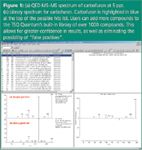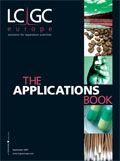Quantitation-Enhanced Data-Dependent (QED) Scanning of Drinking Water Samples Using EQuan for Pesticide Analysis
The Application Notebook
This application note describes an LC–MS–MS method for on-line sample preparation and concentration of drinking water samples prior to analysis using a triple quadrupole with full scan Q3 confirmation.
The use of LC–MS–MS for pesticide analysis has become increasingly popular because of the amenability of electrospray ionization (ESI) for polar compounds. This application describes a multi-residue assay of a group of pesticides in drinking water by the Thermo Scientific EQuan system, using SRM for quantification, followed by data-dependent MS–MS (QED-MS–MS) and library searching for the structural confirmation of these analytes.
Experimental Conditions
Samples: Drinking water was spiked with tricyclazole, carbaryl, carbofuran, asulam, diruon, siduron, daimuron, carpropamid, thiodicarb, azoxystrobin, flazasulphuran, bensulphuron-methyl and halosulphon-methyl (3.0) at concentration levels from 0.5 ppt (pg/mL) to 1000 ppt.
HPLC: Two pump systems were used, a Thermo Scientific Surveyor L-Pump for loading the 1 mL sample onto the loading column (Hypersil GOLD 20 × 2.1 mm 12 μ), and a Surveyor MS Pump Plus for eluting the compounds off the loading column and separation on the analytical column (Hypersil GOLD 50 × 2.1 mm 3 μ).
MS: TSQ Quantum Discovery MAX in positive ESI mode
Results
Excellent linearity and quantitative results were gathered using SRM transitions. Additionally, QED data were collected during each run for each compound. An example of a QED full scan MS–MS spectrum collected during the experiment is shown in Figure 1 for the compound carbofuran. A library search of the QED spectrum is also shown. This QED scan function fragmented the precursor ion m/z 222 for carbofuran over a reverse energy ramp of 10 to 55 eV. Using the built-in environmental compound library available for the TSQ Quantum, which includes over 1000 compounds, carbofuran was the number 1 hit in the list of possible compounds. This feature allows for additional positive confirmation data for compounds that are analysed.

Figure 1
Conclusion
The quantitation-enhanced data-dependent (QED) scan function, standard on all TSQ Quantum mass spectrometers, allows the user to obtain confirmatory data while collecting quantitative data. This is of particular significance when analysing environmental pollutants in water samples. EQuan, with its large injection volume, allows for significant time savings over traditional solid-phase extraction (SPE) concentration methods and allows for detection and quantification of compounds at levels well below the regulatory requirements. The built-in Thermo Scientific library of over 1000 compounds in the industry-standard NIST format can help users to positively identify compounds. Additionally, users have the ability to add to or replace the spectra in the library to increase their positive hit probabilities when searching the library.
Jonathan Beck,1 Mihoko Yamaguchi2 and Kaori Saito,2
1 Thermo Fisher Scientific, San Jose, California, USA,
2 Thermo Fisher Scientific, Yokohama, Japan.

Thermo Fisher Scientific
355 River Oaks Parkway, San Jose, California 95134, USA
tel. +1 561 688 8700 fax +1 608 273 6880
E-mail: analyze@thermo.com Website: www.thermo.com/ms

Characterizing Plant Polysaccharides Using Size-Exclusion Chromatography
April 4th 2025With green chemistry becoming more standardized, Leena Pitkänen of Aalto University analyzed how useful size-exclusion chromatography (SEC) and asymmetric flow field-flow fractionation (AF4) could be in characterizing plant polysaccharides.












